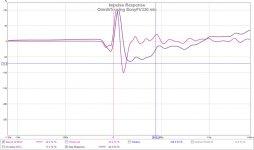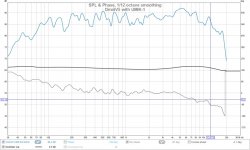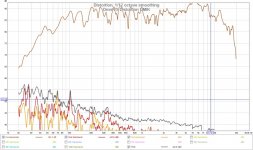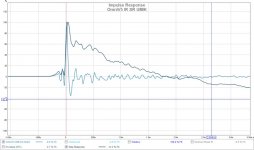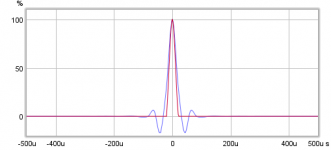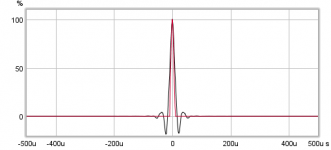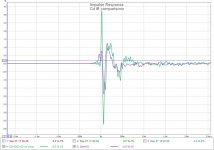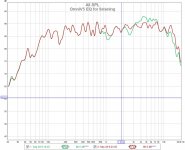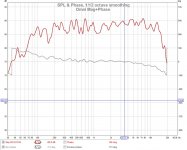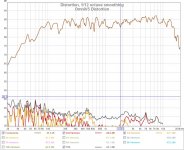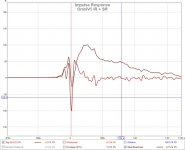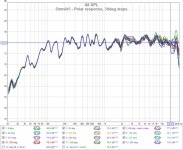It's a little strange as the step of the logitech generally follows the direction of the IR but it is such a mess it is not much confirmation. It also looks inverted...
Agree and a logic guess is the mess must be kind of HF related glitches/distortion because low passed woofer IR seen at post 205 looked by the book.
weird impulse - mid test observations
Thanks @fluid and @byrtt and @juhazi for all the suggestions and feedback.
After many (really many) tests I have the following observations.
1) My amp changes phase depending on the mode you select. "Pure Direct" will invert (180deg) but "Straight" and "Stereo" will not invert. This is odd because the pure direct is suppose to be the least altered sound. Maybe its just the sound chain, but I would think it should at least be consistent across modes.
2) The drivers are the correct polarity, regardless of the weirdness discovered. I do agree there is weirdness here.
3) After many configurations of speakers, amps, and driver only I have noticed similar IR and SR defects on all of them. The common denominator is the measurement system, so it is suspect.
4) I tried another system (laptop with REW), using the same Omni mic and it gave me similar results. Although I do like using a laptop because there is less LF fan noise.
5) I tried a less than ideal mic (Sony FV320) which is directional, to compare to the omnidirectional mic. The measured FR's are similar but the mathematically synthesized IR and SR are very different. Graph#1 is for the near field system.
I should have a UMIK-1 by Weds, and I'll post results.
Thanks @fluid and @byrtt and @juhazi for all the suggestions and feedback.
After many (really many) tests I have the following observations.
1) My amp changes phase depending on the mode you select. "Pure Direct" will invert (180deg) but "Straight" and "Stereo" will not invert. This is odd because the pure direct is suppose to be the least altered sound. Maybe its just the sound chain, but I would think it should at least be consistent across modes.
2) The drivers are the correct polarity, regardless of the weirdness discovered. I do agree there is weirdness here.
3) After many configurations of speakers, amps, and driver only I have noticed similar IR and SR defects on all of them. The common denominator is the measurement system, so it is suspect.
4) I tried another system (laptop with REW), using the same Omni mic and it gave me similar results. Although I do like using a laptop because there is less LF fan noise.
5) I tried a less than ideal mic (Sony FV320) which is directional, to compare to the omnidirectional mic. The measured FR's are similar but the mathematically synthesized IR and SR are very different. Graph#1 is for the near field system.
I should have a UMIK-1 by Weds, and I'll post results.
Attachments
Thanks feedback of all your recent work.
In recognize you are on USB microphone and it happen to be MS OS Win8 or up in mean time you could try run REW in compatibility mode as WinXP SP3 or alternative Win7, reason is in past member bwaslo reported Win8 to limit dynamic range on USB bus. Its very easy tweak to try out and change it back to native should it not work and give a difference, "roomeqwizard.exe" is to find into path "C:\Program Files (x86)\REW" and if you right click it set it to WinXP SP3 mode and start REW and make a sweep to see if it changes anything, else change it back to native and wait to UMIK-1 arrive. Regarding UMIK-1 my own show its native locked at 48kHz so suggest when time comes always run measurement program and OS/soundcard set to 48kHz rate.
In recognize you are on USB microphone and it happen to be MS OS Win8 or up in mean time you could try run REW in compatibility mode as WinXP SP3 or alternative Win7, reason is in past member bwaslo reported Win8 to limit dynamic range on USB bus. Its very easy tweak to try out and change it back to native should it not work and give a difference, "roomeqwizard.exe" is to find into path "C:\Program Files (x86)\REW" and if you right click it set it to WinXP SP3 mode and start REW and make a sweep to see if it changes anything, else change it back to native and wait to UMIK-1 arrive. Regarding UMIK-1 my own show its native locked at 48kHz so suggest when time comes always run measurement program and OS/soundcard set to 48kHz rate.
Good points there fluid that said it cost nothing but a few time try it out : )
Another note is from own experience in general using computer as precision instrument often better coherent results is achieved use I/O's from the same soundcard (common clock), have one UMIK-1 and UMM-6 myself but more staple and coherence measurements is experienced using analog microphone on whatever soundcard same interface I/O's.
Another note is from own experience in general using computer as precision instrument often better coherent results is achieved use I/O's from the same soundcard (common clock), have one UMIK-1 and UMM-6 myself but more staple and coherence measurements is experienced using analog microphone on whatever soundcard same interface I/O's.
I agree with using the same soundcard for I/O.
Having a synchronous I/O system with the same clock domain would be best. It would have the most predictable phase performance. However, it still leaves me with a lingering doubt as to how accurate [mag,phase] my current measuring system is. Another omni mic (UMIK) will remove the doubt, and allow me to calibrate another system.
@fluid, I agree with REW that 16b is sufficient, otherwise you'd just get higher resolution noise.
@byrtt, I use Win7pro-64 so hopefully I'll get predictable performance.
Having a synchronous I/O system with the same clock domain would be best. It would have the most predictable phase performance. However, it still leaves me with a lingering doubt as to how accurate [mag,phase] my current measuring system is. Another omni mic (UMIK) will remove the doubt, and allow me to calibrate another system.
@fluid, I agree with REW that 16b is sufficient, otherwise you'd just get higher resolution noise.
@byrtt, I use Win7pro-64 so hopefully I'll get predictable performance.
Last edited:
Very true, my point was that if you use the Java Drivers at 16bit then whatever you do to Windows to allow the USB Mic to input the full 24Bits will be undone in REWthat said it cost nothing but a few time try it out : )
I honestly don't remember if there is a setting to change the bit depth with ASIO drivers but the UMIK doesn't have them.
I have taken my best measurements by using a calibrated mic using the mic preamp and DAC from the same soundcard and that was part of the reason I bought it. When I use another DAC for output it still works quite well but the impulse gets a soft ramp start to it I assume from the clock drift.
For Don the UMIK is definitely a step in the right direction for not much outlay. It is also level calibrated which is useful if another system is used later. I often consider getting one for that reason
Attachments
Test again, using UMIK-1
After much fiddling about, a UMIK-1 was used to remeasure everything. There were a couple of issues to fix, but with a known reference point it made finding them a lot easier.
Credit to where its due, @fluid and @byrtt were correct, my CD was reversed. The CD terminals are actually labelled incorrectly. The FR hole is from the woofer rolling off too soon (more on that) so I have EQ'd the hole (1100-1800Hz) out for now, the rest is untouched. The notch filters are still required, although I might tweak the attn abit.
Interestingly 1) a reversed tweeter with no FR hole, sounds better than 2) a correct tweeter with an FR hole, but not as good as 3) a correct tweeter with no FR hole.
I think my IR and SR look proper now, the distortion levels are lower, the FR is flatter (mic cal) although rolling off sooner on the HF end.
After much fiddling about, a UMIK-1 was used to remeasure everything. There were a couple of issues to fix, but with a known reference point it made finding them a lot easier.
Credit to where its due, @fluid and @byrtt were correct, my CD was reversed. The CD terminals are actually labelled incorrectly. The FR hole is from the woofer rolling off too soon (more on that) so I have EQ'd the hole (1100-1800Hz) out for now, the rest is untouched. The notch filters are still required, although I might tweak the attn abit.
Interestingly 1) a reversed tweeter with no FR hole, sounds better than 2) a correct tweeter with an FR hole, but not as good as 3) a correct tweeter with no FR hole.
I think my IR and SR look proper now, the distortion levels are lower, the FR is flatter (mic cal) although rolling off sooner on the HF end.
Attachments
Ha ha and if anybody in your house or ship complain about bear time tell them from me and probably also fluid that you deserved it after a long troubleshooting period, and also who wouldn't drink on the new better distortion curve...It's beer time on the deck.
About how they label polarity red and black for especially compression drivers think its more or less right what they do in light of diagraph move direction but often diagraph ends up mounted turned around inside so maybe it was better they also printed info about that and what to expect using red or black as positive wire.
I'm thinking you mean beerHa ha and if anybody in your house or ship complain about bear time tell them from me and probably also fluid that you deserved it after a long troubleshooting period, and also who wouldn't drink on the new better distortion curve
 and not bear because that could also happen in Canada
and not bear because that could also happen in Canada Glad you got it sorted out Don that looks a whole lot better. Never trust a manufacturer to get anything right
For a passive that is a pretty good step and IR now.
Mini DSP has a 90 degree calibration file you can download then you can use that with the mic and point it straight up or down instead of needing to point it at the speaker, works well for in room measurements if you don't do it that way already.
@fluid thanks for the help.
I downloaded both UMIK-1 correction files and tried them. I would use the 0 deg for near field and the 90 deg for far field and room.
REW also plots the mic correction curve which is nice. Other than the lack of any configuration options, the UMIK is a nice mic and very easy to get running. REW even recognizes it with a pop up window to select it and the config file. Nice integration.
I downloaded both UMIK-1 correction files and tried them. I would use the 0 deg for near field and the 90 deg for far field and room.
REW also plots the mic correction curve which is nice. Other than the lack of any configuration options, the UMIK is a nice mic and very easy to get running. REW even recognizes it with a pop up window to select it and the config file. Nice integration.
Last edited:
Nice to hear that problems got cleared out! Cheers!
I use UMIK-1 and REW too, it is just fine for acoustic measurements of the room and adjusting an active/dsp multiway speaker. Getting data for loudspeaker design software is different scenario, then a two-way soundcard and passive mic is needed.
I use UMIK-1 and REW too, it is just fine for acoustic measurements of the room and adjusting an active/dsp multiway speaker. Getting data for loudspeaker design software is different scenario, then a two-way soundcard and passive mic is needed.
Last edited:
REW has an acoustic timing option now too, so you can use a USB mic and get time locked measurements. I can't vouch for how good the method is having never tried it.Getting data for loudspeaker design software is different scenario, then a two-way soundcard and passive mic is needed.
I'll post a comparison of the sound card loop back vs usb acoustic loopback.
I plan on reusing my vanilla omni electret mic and PC soundcard after I figure out what went wrong. I'll generate my own calibration file, now that I have a calibrated reference. I would like to use it for parameter measurements.
The acoustic timing seems to works fine and is a necessity for me.
I plan on reusing my vanilla omni electret mic and PC soundcard after I figure out what went wrong. I'll generate my own calibration file, now that I have a calibrated reference. I would like to use it for parameter measurements.
The acoustic timing seems to works fine and is a necessity for me.
In some REW loopback test discovered setting "End Freq" dialog to numbers less than half the pass band adds more pre/post ringing to IR, expect not same had happened into this thread but share because think info should be good to know.
In examples below red traces show the perfect domain when using soundcards digital I/O looped, in first example sample rate is 96kHz and "End Freq" (black trace) set to 22.050Hz and in second example sample rate is 48kHz and "End Freq" (blue trace) set to 11.999Hz.
In examples below red traces show the perfect domain when using soundcards digital I/O looped, in first example sample rate is 96kHz and "End Freq" (black trace) set to 22.050Hz and in second example sample rate is 48kHz and "End Freq" (blue trace) set to 11.999Hz.
Attachments
Last edited:
In some REW loopback test discovered setting "End Freq" dialog to numbers less than half the pass band adds more pre/post ringing to IR, expect not same had happened into this thread but share because think info should be good to know.
In examples below red traces show the perfect domain when using soundcards digital I/O looped, in first example sample rate is 96kHz and "End Freq" (black trace) set to 22.050Hz and in second example sample rate is 48kHz and "End Freq" (blue trace) set to 11.999Hz.
That's good to know thanks. If you enjoy the details, you'll find the next post interesting.
Finally,.... a consistent explanation for the weird impulse
I have been struggling to explain a weird impulse, inconsistent observations, and partial solutions. After listening to a "reversed" tweeter for a bit, it sounded wrong. After trying to EQ an FR hole (1100-1800Hz) at the XO point, it was clearly a series of notch(es) that could not fully be EQ'd out. So reversing the tweeter is not a solution, even if it does result in a beautiful IR + SR.
After doing a bit a research I found an excellent article at Proper Signal (Time) Alignment—Getting Loudspeaker Drivers In Sync - ProSoundWeb that gave me some insight. It caused me to start tearing things apart (yet again), remeasuring and coming to a different, but observational consistent, explanation.
Internal inconsistencies in the previous observations:
1) with normal tweeter (CD) polarity, the IR+SR are weird, but the FR mag and phase are really good (linear).
2) with the CD reversed, the IR+SR look really good, but the FR has a hole and the phase is strange.
3) the mfg FANE130 spec states +ve on red , causes +ve throat pressure
I recently started using a UMIK-1 instead of my soundcard and the details suddenly become a lot clearer. I compared the CD+WG without cone, to the CD+WG with cone. Most of the IR weirdness is a result of HF from the CD. Graph#1 clearly shows the problem, and why it "appears" that the CD is reversed. The CD is labelled correctly, has the correct phase, and without the cone, shows the initial +ve pulse, following by a large undershoot (low damping). When the cone is in place, the initial rising +ve pulse is destroyed and all that is left is the initial -ve undershoot making the tweeter "look" reversed. In fact the destroyed +ve pulse now looks like ringing in the soundcard, but it is not. There is a lot of math that is being done to create the IR+SR from FR and I believe it is correct but I'm not sure how important it is. I can tweak the HF cone tip and get a change in the initial rising pulse and the IR + SR. It's still weird, but now I know where to look.
I wish I had the UMIK last week
I have been struggling to explain a weird impulse, inconsistent observations, and partial solutions. After listening to a "reversed" tweeter for a bit, it sounded wrong. After trying to EQ an FR hole (1100-1800Hz) at the XO point, it was clearly a series of notch(es) that could not fully be EQ'd out. So reversing the tweeter is not a solution, even if it does result in a beautiful IR + SR.
After doing a bit a research I found an excellent article at Proper Signal (Time) Alignment—Getting Loudspeaker Drivers In Sync - ProSoundWeb that gave me some insight. It caused me to start tearing things apart (yet again), remeasuring and coming to a different, but observational consistent, explanation.
Internal inconsistencies in the previous observations:
1) with normal tweeter (CD) polarity, the IR+SR are weird, but the FR mag and phase are really good (linear).
2) with the CD reversed, the IR+SR look really good, but the FR has a hole and the phase is strange.
3) the mfg FANE130 spec states +ve on red , causes +ve throat pressure
I recently started using a UMIK-1 instead of my soundcard and the details suddenly become a lot clearer. I compared the CD+WG without cone, to the CD+WG with cone. Most of the IR weirdness is a result of HF from the CD. Graph#1 clearly shows the problem, and why it "appears" that the CD is reversed. The CD is labelled correctly, has the correct phase, and without the cone, shows the initial +ve pulse, following by a large undershoot (low damping). When the cone is in place, the initial rising +ve pulse is destroyed and all that is left is the initial -ve undershoot making the tweeter "look" reversed. In fact the destroyed +ve pulse now looks like ringing in the soundcard, but it is not. There is a lot of math that is being done to create the IR+SR from FR and I believe it is correct but I'm not sure how important it is. I can tweak the HF cone tip and get a change in the initial rising pulse and the IR + SR. It's still weird, but now I know where to look.
I wish I had the UMIK last week

Attachments
OmniV5 polar FR
I remeasured the polar response using the UMIK, just to have a consistent data set. Most of the variation is >14KHz, presumably from the 3 supporting posts. Graph#1 is for 30deg steps, includes room acoustics (no FDW), at 30cm from mid disk height.
I remeasured the polar response using the UMIK, just to have a consistent data set. Most of the variation is >14KHz, presumably from the 3 supporting posts. Graph#1 is for 30deg steps, includes room acoustics (no FDW), at 30cm from mid disk height.
Attachments
- Home
- Loudspeakers
- Multi-Way
- OmniDirectional - work in progress
